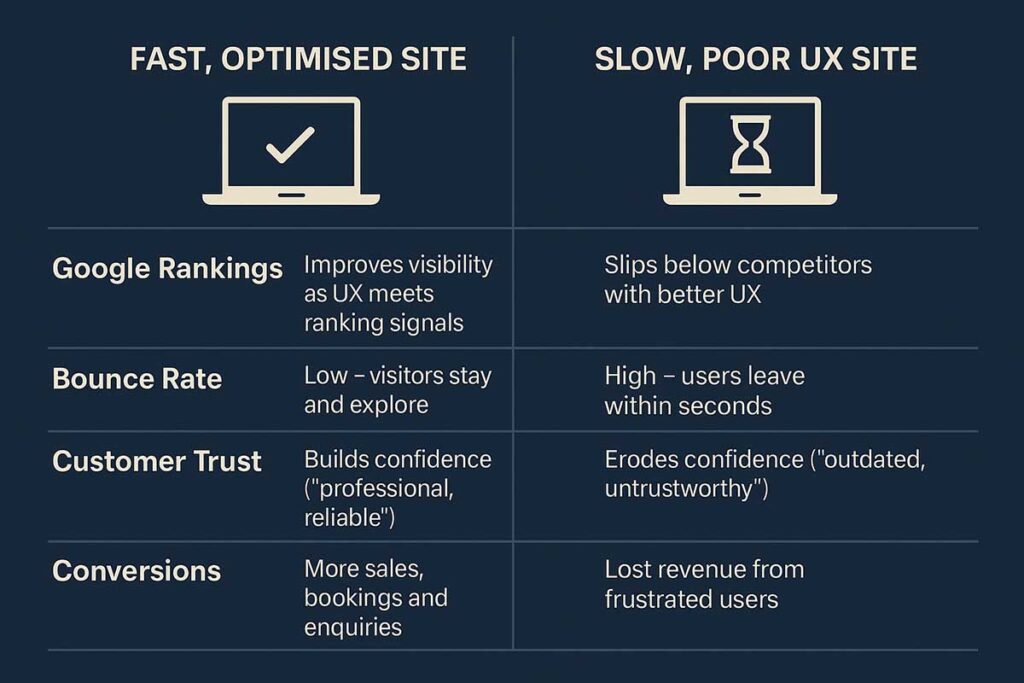Why Core Web Vitals Matter
Not long ago, SEO was primarily focused on keywords and backlinks. Get enough of them and you’d usually rank well. However, by 2025, that approach no longer suffices. Google now cares just as much about how people experience your site as it does about what’s on it.
That’s where Core Web Vitals come in. They’re a set of simple measurements Google uses to check if your website is fast, stable, and easy to use. If your site frustrates people, your rankings will suffer, even if your content is brilliant.
For businesses in Bournemouth, Poole, Dorset, and across the UK, this is a big deal. SEO isn’t just about words on a page; it’s about whether your website gives customers a smooth experience.
The Three Core Web Vitals (Explained Without the Tech Jargon)
1. LCP (Largest Contentful Paint) – How fast your page loads
If your main headline or image takes more than 2.5 seconds to load, users leave before they even see your offer.
- Example: A local florist’s homepage takes 6 seconds to load. Customers leave before browsing bouquets. Competitors with faster sites win the sale.
2. CLS (Cumulative Layout Shift) – How stable your page is
When buttons or text move around while loading, people get frustrated and click the wrong thing.
- Example: A Bournemouth solicitor’s “Book a Call” button shifts when ads load. Visitors mis-click, lose patience, and the firm loses leads.
3. INP (Interaction to Next Paint) – How responsive your site feels
If a user clicks “Buy Now” or “Submit” and the site takes too long to react, it feels broken. Google tracks this responsiveness.
- Example: A Poole restaurant’s booking form lags when tapped. Users abandon and book elsewhere.
Why This Impacts Your SEO
Google rewards sites that customers enjoy using. If your site is slow, unstable, or clunky, people bounce. Google sees that and ranks competitors higher.
That’s why Core Web Vitals are now official ranking factors, right alongside keywords and backlinks.
Fast vs Slow Sites: The Real-World Impact
Here’s what happens when you compare a site that nails Core Web Vitals with one that doesn’t:
| Factor | Fast, Optimised Site | Slow, Poor UX Site |
| Google Rankings | Improves visibility as UX meets ranking signals | Slips below competitors with better UX |
| Bounce Rate | Low — visitors stay and explore | High — users leave within seconds |
| Customer Trust | Builds confidence (“professional, reliable”) | Erodes confidence (“outdated, untrustworthy”) |
| Conversions | More sales, bookings, and enquiries | Lost revenue from frustrated users |
| Mobile Experience | Smooth and responsive | Clunky and abandoned |
Bottom line: SEO might bring people to your site, but Core Web Vitals determine whether they stay and whether they make a purchase.
Want to Improve Your SEO Rankings?
Strong SEO means more visibility, more traffic, and more customers. At Digital Hype, we specialise in helping businesses across Bournemouth, Poole, Dorset and UK-wide climb Google rankings with strategies that actually deliver results. Let’s build an SEO plan that grows your business for the long term.
Contact Our SEO ExpertsHow to Improve Core Web Vitals (Practical Fixes You Can Use)
Improving Core Web Vitals isn’t just for developers. Here are simple steps any business can take:
- Upgrade hosting & caching – cheap servers slow you down.
- Optimise images – oversized photos can slow down loading speed.
- Remove old plugins/scripts – fewer moving parts = faster site.
- Mobile-first web design – most customers are on phones, so your site must adapt.
- Use schema markup – helps Google understand and trust your site.
- Simplify forms – make buying or booking instant and hassle-free.
Dorset Example: A Retailer That Fixed Its Core Web Vitals
One e-commerce retailer in Dorset appeared to be successful on the surface, but had slow loading times and inconsistent layouts. After a site tune-up:
- Load time dropped from 5 seconds to under 2.
- Pages stopped “jumping” when banners loaded.
- Checkout forms became instant.
The outcome? A 28% increase in online sales in just two months.
FAQs: Core Web Vitals and SEO
Q1. Do Core Web Vitals affect Google rankings?
Yes — they’re now part of the ranking system.
Q2. What happens if my site fails them?
You won’t be penalised directly, but competitors with faster, smoother sites will outrank you.
Q3. Are they more important on mobile or desktop?
Both, but mobile carries more weight since most traffic is mobile-first.
Q4. Can I easily check my Core Web Vitals?
Yes — Google PageSpeed Insights and Search Console both offer free reports.
Q5. Is it expensive to fix them?
Not always. Minor changes (like image compression) often make a significant impact.
Q6. Do keywords still matter if my site is slow?
Yes — but poor UX means the traffic you win won’t convert into sales.
Q7. Should small businesses care?
Absolutely. Core Web Vitals level the playing field against bigger brands.
Q8. How soon will I see results?
Improvements often show within weeks once Google re-crawls your site.
Future-Proof Your Rankings with UX & SEO
SEO isn’t just about being found; it’s about delivering a site that feels effortless to use. Core Web Vitals are Google’s way of making sure your site is fast, stable, and user-friendly.
At Digital Hype, we help businesses across Bournemouth, Poole, Dorset, and the wider UK combine SEO strategy with high-performance web design, enabling you to rank higher and convert more visitors into customers.


